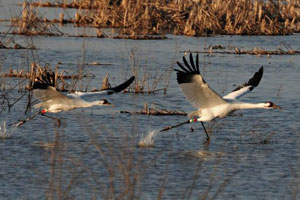Main Content
Article
Whooping Cranes
The whooping crane (Grus americana) is a federal and state-endangered species. It is the tallest bird in North America.
General Characteristics
Physical Characteristics
- Bright white plumage with crimson cap.
 Long necks and long black legs.
Long necks and long black legs.- Stout straight black bill.
- Average weight is 15 pounds.
- Can reach up to 5 feet tall.
- Its trachea is 5 feet long, coiling into its sternum allowing for these cranes to give loud calls.
Behavioral Characteristics
- Slow-moving birds that browse for food.
- Occur in small flocks (2-6 birds) or in singles.
- Courtship dances involve leaping, kicking, head-pumping and wing-sweeping.
Status and Distribution
Whooping cranes observed in Indiana are the result of a restoration effort by the Whooping Crane Recovery Team, an international coalition of governmental agencies and private organizations to establish a migratory population of whooping cranes in the eastern United States. Between 2001 and 2016, captive-bred whooping cranes were taught to follow ultralight aircraft to learn a migration route from central Wisconsin to the Gulf Coast of Florida. Until 2008, this route took them through Indiana. Now, free-flying birds regularly stop in Indiana during the fall and spring seasons. Birds are also released in the company of older cranes from whom the young birds are expected to learn the migration route. Once led south, the cranes are able to migrate on their own, without assistance, in following years.

In the spring and fall, staff from the International Crane Foundation and the U.S. Fish and Wildlife Service track and monitor the released cranes to learn as much as possible about their unassisted journeys and the habitat choices they make both along the way and on their summering and wintering grounds. Most birds have unique combinations of colored bands as well as a radio or satellite transmitter. Not all transmitters are functional, however, so public sightings of whooping cranes are of great help in tracking these birds. If someone observes a whooping crane in Indiana, it is important to report them at www.savingcranes.org/report-whooping-crane.
Whooping cranes were on the verge of extinction in the 1940s. In 2020, there were only about 826 birds in existence, 662 of them in the wild. Aside from the 80 birds in the Eastern flock, the only other migrating population of whooping cranes nests at the Wood Buffalo National Park in the Northwest Territories of Canada and winters at the Aransas National Wildlife Refuge on the Texas Gulf Coast. A non-migrating flock of approximately 69 birds lives year-round in Louisiana.
In Indiana, whooping cranes are listed as federally endangered and state endangered.
Food Habits
Whooping cranes feed on:
- Crabs
- Clams
- Frogs
- Aquatic plants
- Insects
- Seeds
- Berries
- Snakes
Management and Conservation
Whooping cranes, and all other nongame wildlife, are researched and managed by wildlife biologists within the Division of Fish & Wildlife. All projects are funded through donations to the Indiana Nongame Wildlife Fund. The only self-sustaining population of whooping cranes is a flock that breeds in Canada and over-winters in Texas. Two reintroduced populations exist with the help of captive breeding programs as described above. For more information, visit www.savingcranes.org/category/whooping-crane.
Anyone who encounters a whooping crane in the wild should give them the respect and distance they need. Please follow these guidelines to safely view whooping cranes:
- Do not approach birds on foot within 200 yards (i.e. the length of two football fields)
- Try to remain in your vehicle;
- Do not approach in a vehicle within 100 yards (i.e. the length of one football field)
- Remain concealed and whisper to prevent birds from being disturbed.
- Do not trespass on private property in an attempt to view whooping cranes.
If you observe any instances of whooping crane harrassment, disturbance or poaching, report it immediately to 1-800-TIP-IDNR.
For more information on how you can help whooping cranes in Indiana, visit the Hoosier for Whoopers website at www.savingcranes.org/indiana
Want To Help Whooping Cranes?
Whooping crane monitoring and research in Indiana is funded, in part, by citizen donations to the Indiana Nongame Wildlife Fund. To support this project and others like it, visit our donation page.
